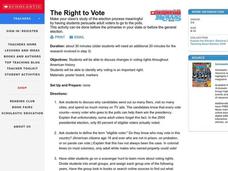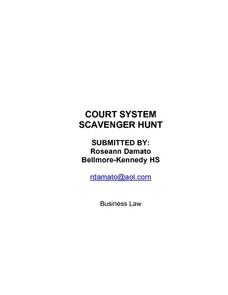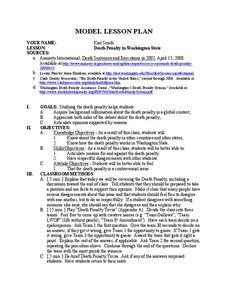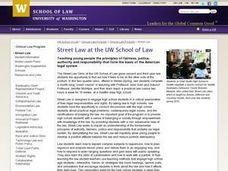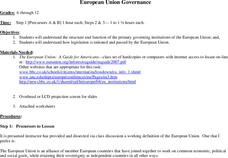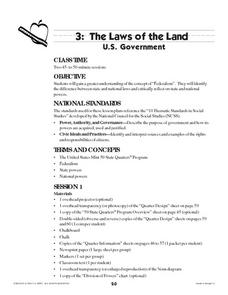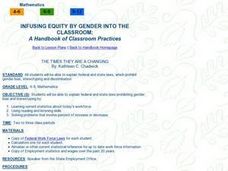Curated OER
The Right to Vote
In this voting worksheet, students identify and discuss changes in voting rights throughout American history.
Then, they identify why voting is an important right for Americans. Finally, students create voting bookmarks instead of or in...
Curated OER
Court System Scavenger Hunt
Students are assign a particular Federal or State Court. They are asked to make a poster of the court they have been assigned. Students are told that the poster should include a list of the types of cases that particular court hears. ...
Curated OER
Affirmative Action
Learners explore policies concerning affirmative action. After reading affirmative action handouts, students use the internet and other resources to research information about affirmative action laws, court cases, and arguments. They...
National First Ladies' Library
Mrs. Wilson's Alley Bill
Learners read and understand Ellen Wilson's bill. They review the federal law-making procedure and understand the implications of an appropriation bill to redress housing concerns during a time of looming war. Classmates are split...
Curated OER
Against The Tide: Three Who Made It!
Students examine the lives of three people from New Haven, Connecticut who have careers in law, politics and entertainment. In groups or individually, they read excerpts of information about the three people and what contributions they...
Curated OER
Juvenile Justice-Disposition
Students explore the dispositional hearing as a part of the juvenile justice system. After a brief discussion of the parts of the disposition hearing, students work in groups to review case studies involving juveniles in Utah's justice...
Curated OER
The Death Penalty
Learners examine how people are punished in the American justice system. In groups, they identify the four different theories of punishment and how it is used in the justice system. They use the internet to read arguments for and against...
Curated OER
Torts: Intentional Torts
High schoolers are introduced to the concept of intentional torts. In groups, they compare and contrast civil and criminal wrongs committed by people. They are given case studies and use the elements of torts to apply to them. They share...
Curated OER
Employment Law
High schoolers begin their examination of Employment Law. In groups, they identify the types of protections in place for employees and examine situations in which their rights were violated. They act out various skits and discuss the new...
Curated OER
Tort Hypotheticals
Students review the use of intentional torts. In groups, they use specific statements and use them in hypothetical situtations. For each category, they write a statements about the situation and discuss them as a class. They complete a...
Curated OER
European Union Governance
Students explore the government functions of the European Union and how legislation is passed. As a class, students define the European Union and their interests in economic, political and social issues. Using the internet, students...
Curated OER
Children in the Labor Force
Students, after reading the articles "Historical Background" and "Progressive Era: Child Labor," create a two to three page document using Inspiration that deals with either the reasons children worked, child labor laws and Lewis Hine's...
Curated OER
Introduction to Contracts
High schoolers are introduced to the concept of contracts in street law. In groups, they compare and contrast contract law with tort law. They identify the basic concepts of each and view examples to see the concepts in use. They also...
Curated OER
Law, Values and Lobbying
High schoolers begin to examine the lawmaking process. Using their text, they describe the role of the three branches of government. In groups, they identify the four basic values protected by law and define the concept of lobbying and...
Curated OER
Toxic Torts
Twelfth graders examine the role of courts in environmental law enforcement. Using examples, they identify civil cases brought against large corporations for violating environmental laws. They define new vocabulary and discuss the...
Curated OER
Stepping Inside the Flowchart: How Does a Bill Become a Law?
Students explore the steps a bill must pass through to become a law and create a flow chart that maps the complexities of the process. They research the committees that are involved in a bill that relates to energy policy and the...
Curated OER
How to Write a Bill
Students view video excerpts from, "Mr. Smith Goes to Washington" and discuss them to brainstorm how to write a bill. They divide into two groups representing senate committees to participate in a mark-up session where they read and...
Curated OER
I'm Just a Bill
Fourth graders study the three branches of government and the process of how a bill becomes a law. They watch the School House Rock video "I'm Just a Bill" and sing the song after viewing the video. They answer question regarding a bill...
Curated OER
A Day in the Life of Bill C-One: Canada's Parliamentary System
Studnets explore the procedure that makes bills into laws, through research and class discussion. They conduct public opinion and media research surveys and discuss the impact they have on deliberations conducted during the passage of a...
Curated OER
The Rule of Law
Students examine the rule of law and government in this civics lesson. They discover the origins and how it impacts them on a daily basis. They also analyze its role in the judicial system.
Curated OER
The Laws of the Land
Pupils examine state quarters and discuss how national and state agencies worked together to create them. They examine state laws and national laws to see how they differ. They explore the process for making a law.
Curated OER
Following the Law
Students discriminate between what makes a rule or law good or bad. They each choose a classroom problem and come up with a rule to solve it. They present their rules to the class, who discusses whether to adopt the rule.
Curated OER
Jaywalking
Pupils study the consequences of breaking laws. They role-play jaywalking and what could happen if they participate in this behavior.
Curated OER
Gender Equity in the Classroom
Students review employment statistics and wages over the past 20 years. They examine the Federal Work Force Laws. They apply formulas to find the rate of change in the minimum wage.
